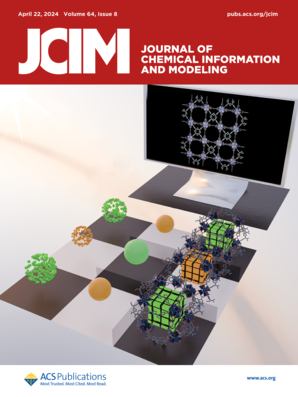揭示人类芳香化酶与细胞色素P450还原酶在真实膜环境中相互作用动力学的新见解。
IF 5.6
2区 化学
Q1 CHEMISTRY, MEDICINAL
引用次数: 0
摘要
在真实的内质网膜环境下,对人芳香化酶(HA)与细胞色素P450还原酶(CPR)进行了分子动力学模拟,以评价其结构和动力学特性。研究发现,CPR有一个特定的点突变(P281T),其中脯氨酸被苏氨酸取代,这将对其结构、动力学和电子转移行为产生深远影响。由于CPR在向HA的电子转移、催化甾体生成中起着关键作用,因此获得CPR对HA突变效应的详细信息至关重要。这迫使我们研究HA与野生型和突变型CPR的相互作用,从而研究CPR的不同特性及其对HA动力学的影响。为了实现这些目标,研究人员应用了不同的分析参数,特别是均方根偏差、均方根波动、动态相互关联矩阵和主成分分析,以深入了解HA/CPR复合物的构象动力学。这些分析表明,在心肺复苏术突变对血凝素行为影响的背景下,复苏术的动态变化。基于这些信息,HA/CPR复合物内的电子转移也被设想受到两种复合物之间对比动力学的影响,因为评估突变会显着改变CPR和HA的动力学。此外,应用Marcus电子转移理论确定了复合物内的电子转移,揭示了HA/野生型和突变型CPR复合物之间的对比。后者被发现改变了电子传递效率,证明了在HA/突变型CPR复合体中观察到的蛋白质动力学变化的直接影响。因此,这项研究为HA与CPR结合的构象动力学提供了有价值的见解,影响电子传递过程及其对理解受这些蛋白质影响的雌激素相关生理状况的潜在意义。本文章由计算机程序翻译,如有差异,请以英文原文为准。
Revealing New Insights into the Dynamics of Human Aromatase Interacting with Cytochrome P450 Reductase in a Realistic Membrane Environment.
Molecular dynamics simulations were applied to human aromatase (HA) complexed with cytochrome P450 reductase (CPR) within a realistic endoplasmic reticulum membrane environment to evaluate its structural and dynamical properties. CPR was examined to have a specific point mutation (P281T), where proline was substituted by threonine, which is envisaged to demonstrate a far-reaching influence on its structure, dynamics, and electron transfer behavior. Since CPR plays a key role in the electron transfer to HA, catalyzing steroidogenesis, obtaining detailed information on the mutation effect of CPR on HA was crucial. This compelled us to study the interaction of HA with CPR in its wild-type and mutant forms, enabling the investigation of different properties of CPR and its effect on HA dynamics. Pursuing these objectives, different analytical parameters, notably, root-mean-square deviation, root-mean-square fluctuation, dynamic cross-correlation matrix, and principal component analysis were applied to gain insight into the conformational dynamics of the HA/CPR complex. These analyses demonstrated the CPR shifts in the complexes' dynamics, in the context of the effect of CPR mutation effects on HA behavior. Based on this information, the electron transfer within the HA/CPR complex was also envisaged to be influenced by the contrast dynamics between the two complexes as the mutation was evaluated to significantly alter the dynamics of CPR as well as HA. Furthermore, the electron transfer within the complexes was determined by applying Marcus theory of electron transfer, revealing a contrast between the HA/wild-type and mutant CPR complexes. The latter was found to alter the electron transfer efficiency, demonstrating a direct effect of changes in the protein dynamics observed within the HA/mutant CPR complex. This study therefore provides valuable insights into the conformational dynamics of HA in conjunction with CPR, affecting the electron transfer process and their potential implications for understanding estrogen-related physiological conditions influenced by these proteins.
求助全文
通过发布文献求助,成功后即可免费获取论文全文。
去求助
来源期刊
CiteScore
9.80
自引率
10.70%
发文量
529
审稿时长
1.4 months
期刊介绍:
The Journal of Chemical Information and Modeling publishes papers reporting new methodology and/or important applications in the fields of chemical informatics and molecular modeling. Specific topics include the representation and computer-based searching of chemical databases, molecular modeling, computer-aided molecular design of new materials, catalysts, or ligands, development of new computational methods or efficient algorithms for chemical software, and biopharmaceutical chemistry including analyses of biological activity and other issues related to drug discovery.
Astute chemists, computer scientists, and information specialists look to this monthly’s insightful research studies, programming innovations, and software reviews to keep current with advances in this integral, multidisciplinary field.
As a subscriber you’ll stay abreast of database search systems, use of graph theory in chemical problems, substructure search systems, pattern recognition and clustering, analysis of chemical and physical data, molecular modeling, graphics and natural language interfaces, bibliometric and citation analysis, and synthesis design and reactions databases.

 求助内容:
求助内容: 应助结果提醒方式:
应助结果提醒方式:


